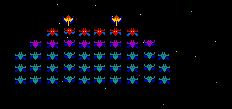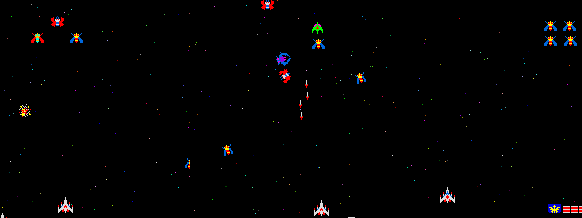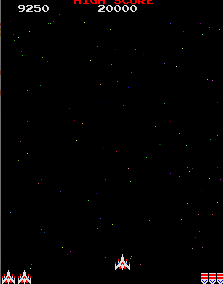Metamorphosis: From Galaxian to Galaga
Having studied Galaxian (1979) and its imitators from the following year, lets look in detail at the culmination of the Galaxian design model, Galaga (1981). It might superficially seem that the changes made between these games, like adding bonus rounds and fancier flight patterns, are mostly cosmetic, but when you're starting with something as simple as Galaxian, "frills" can fundamentally alter the character of the gameplay.
Armada
One of the most immediately noticeable advances in Galaga is the dynamic nature of the armada. Not only do the aliens move more fluidly and with more detailed animation, but the formation throbs like a living thing. Fliers come and go like bees from a hive, a nice touch considering all of the enemies are now clearly depicted as bugs.
You'll seldom see the armada in all of its splendor, however. Unlike in Galaxian, the aliens enter the formation gradually at the beginning of the stage, giving you an opportunity to shoot them down before they even reach their position. What's more, thanks to hardware improvements, you can now fire two bullets at a time, greatly increasing the speed at which you can knock out enemies. I found myself completing two stages of Galaga in the time it took to clear one stage of Galaxian, even though there are only six fewer enemies in the Galaga formation.
You might say that this is just a further step in the evolution from Space Invaders. Steadily decreasing the player's interaction with the aliens while in formation means increasing their engagement with the action; that is, the divers.
Divers
The overall design model for the divers remains fundamentally the same between Galaxian and Galaga. In both games, the enemies follow simple, smooth curves that are just the right speed to make targeting difficult, but not impossible. However, Galaga adds many little twists.
One of the most important additions is the two-way dive. The fly enemies, situated at the bottom of the formation, execute large loops that bring them back to their starting position. The loops are simple and smooth, like the other dives, but require you to account for the flies coming from two different directions. Also, the loop is large enough that you're sometimes better off navigating to the middle of it rather than avoiding the enemy entirely.
The above curves are "normal" behavior, but each of the individual divers exhibits some variability. The butterfly's path will respond to the position of the player, veering slightly at the end of its dive depending on which side you're on.
Note that these adjustments are still smooth motions, so they don't take the player by surprise (like in Cosmic Alien), but they do increase the impression that the aliens are aware of you.
The boss also mixes things up, sometimes performing its characteristic loop dive, other times coming out in a straight line to try to "capture" the player.
The capture feature gets a lot of attention because it allows the player to retake their ship and double their firepower, something that's both fun and effective for racking up points. The boss will also take butterflies with it on its pattern, if it's executing its looped dive.
Finally, the fly is the trickiest of them all. Aside the from the standard two-way dive shown, it will sometimes do a full loop and then continue past the player.
This typically comes up at the end of a stage, when most of the armada has been cleared. But that's not all. The fly is also known to morph into other enemies:
When morphing, the fly divides into three of the new enemies, though only one will return to the formation. The last morph, which is a sprite from the original Galaxian, has a significantly different flight pattern that can catch you off guard, so watch out for it.
The aliens also have several entrance patterns to start the level. Overall, the effect of all of these many flight patterns is to add depth to the gameplay. The more you play, the more you learn to anticipate enemy motions.
Enemy Fire
It's difficult to overstate the importance of enemy shot distribution in driving the gameplay of a shooter. In Galaxian, I showed how the enemies fire bullets that lean in the direction of the player, making it seem like the enemies are aware of the player's position. Galaga doubles down on this effect.
In Galaga, the enemy fire is more concentrated and even more focused on the player than in Galaxian, so much so that it changes the character of the game. The curtains of fire that dominated Galaxian put more emphasis on reflexes and spatial awareness. With the more focused fire of Galaga, a clever player has more power to dictate the firing pattern and create their own safe areas without having to duck between bullets.
Bonus Rounds
The simplicity of the Galaxian model is both a strength and a weakness. If you're looking to give the player a sense of progress, then it's a definite weakness, since there is only so much you can change the attacking aliens without changing the character of the game. The bonus rounds (or "Challenging Stages") in Galaga are a clever way around this issue, because they give the player clear signposts in their progress without upsetting the difficulty curve.
The first example of a bonus round in a video game was Sega/Gremlin's Carnival, so it's fitting that the Galaga bonus rounds have a shooting gallery feel to them. The developers clearly wanted to provide Galaga with depth because they designed eight distinct bonus rounds, the last of which won't be seen until you pass stage 30!
The first example of a bonus round in a video game was Sega/Gremlin's Carnival, so it's fitting that the Galaga bonus rounds have a shooting gallery feel to them. The developers clearly wanted to provide Galaga with depth because they designed eight distinct bonus rounds, the last of which won't be seen until you pass stage 30!
Difficulty
In Galaxian, there are very few concrete "facts" that players can learn that will make them better at it. Once you understand the basic rules of the game, getting better requires that you learn to recognize how the game pieces will respond in various conditions, something that can only come from experience.
Galaga, however, is designed to reward specific game knowledge. For example, the first time you play, you're likely to be caught off guard in the second stage when the enemies start firing at you during their entrance, but the next time you play you'll learn to expect this. Similarly, experienced players will learn to recognize enemy entrance patterns, optimal bonus round positions, high scoring opportunities, and the various fly morphs.
This is different from games like Galaxian and Pac-Man. When I lose a life in those games, it's under specific circumstances that will probably only be repeated once in a blue moon. In other words, it's more difficult to apply what I've learned and there's no simple correlation between the knowledge I've gained and the benefits I reap in gameplay. I still improve with time, but the relationship between game knowledge and game success is more complex.
In Galaga, the player's progress is more linear, at least initially. Every time the player learns a new piece of game information, like a particular dive pattern or enemy type, the game rewards them proportionally and they score that much higher. It provides the player with clear ways to improve their game that don't involve rigorous reflex training or countless hours pattern study.
In Galaga, the player's progress is more linear, at least initially. Every time the player learns a new piece of game information, like a particular dive pattern or enemy type, the game rewards them proportionally and they score that much higher. It provides the player with clear ways to improve their game that don't involve rigorous reflex training or countless hours pattern study.
The learning process will eventually slow, however. At some point, you will have learned all there is to know about the Galaga enemy patterns and the rest of your improvement will come down to the same kind of non-linear learning process that you encounter in Galaxian. Manipulating enemy fire, for example, is a complex, highly situational process that cannot be broken down into a small number of facts. I think the combination of linear and non-linear learning processes allows the game to appeal to both casual and hardcore gamers.
Big Picture
Galaga was a huge hit, both commercially and critically, and retains a strong following to this day. For all of its success, however, Galaga actually marked the end of a gaming trend rather than the beginning. Its innovations would be influential on subsequent developers and it would see a sequel in 1984, called Gaplus, but fixed shooters were going out of fashion in arcades. Home systems, however, were breathing new life into the genre. More on that soon.










Comments
Post a Comment